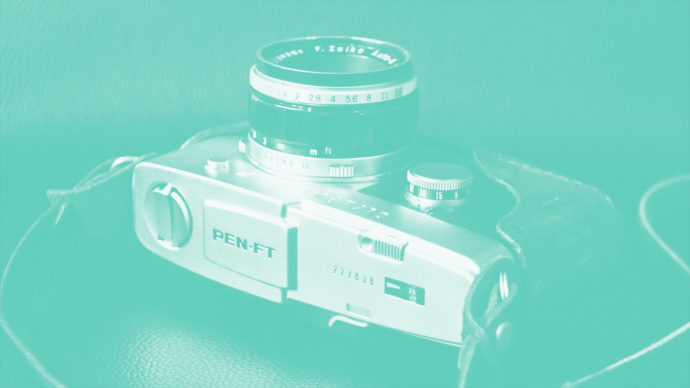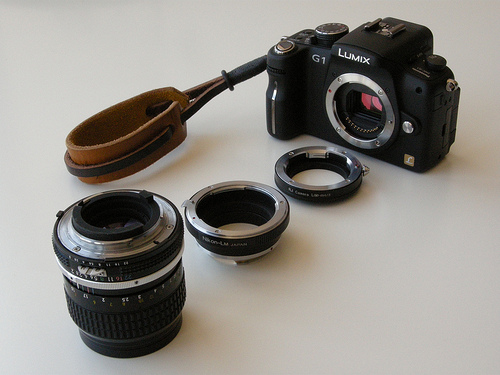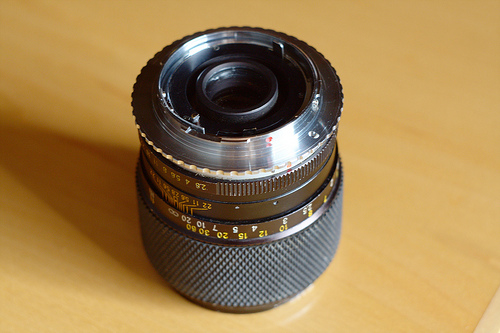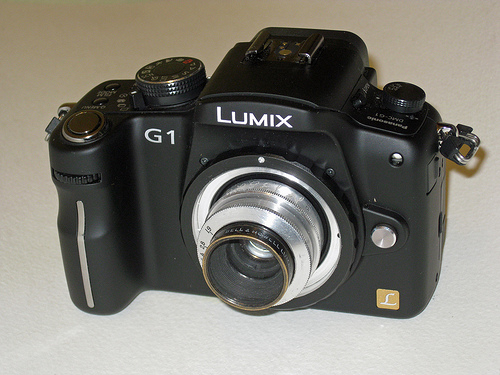As many of you all know, I am a film shooter.
I absolutely love the feel of the old, mechanical cameras in my hands. Everything is manual, from exposure to focus to advancing the frame. There is a certain magic in the old processes for me.
However, as much as I love film, I love the conveniences digital affords me. I love shooting with my digital gear, and I love the flexibility of the RAW format.
I am always looking for ways to merge my film techniques with my digital tools and I create presets to help in capturing that film look without film. I scan my film shots to bring them into the Lightroom workflow.
Focus On The Past, Reshape The Future
I want to discuss one hybrid technique that garners little mention on the photo ecosystem of the internet. The use of archaic manual focus lenses on modern DSLRs. While it is true that in general modern optics are vastly superior to older lenses, there are a few exceptions and even the worst of lenses have characteristics that may be interesting to a modern photographer.

There are a few reasons to use manual focus lenses on modern cameras. First is cost. Lenses are expensive; we all know this painfully well. A good, fast lens can easily run into the thousands, especially with good build quality. Good manual focus lenses can be had for a fraction of the cost of a modern lens, especially when you get into the ultra wide fisheye range. Lenses can be found at thrift stores, yard sales and your older family member’s closets at little or no cost to you.
Find one good manual system, and you can quickly add a number of lenses to your arsenal on the cheap … not to mention that you also have a good film setup in case you get nostalgic.
Second, every lens, modern or archaic, provides unique characteristics to your photography. No two lenses will render a scene exactly the same. The optics and coatings in each lens has an effect on color rendition, sharpness, and bokeh rendition.
I have a Minolta Rokkor-PF 58mm f/1.4 lens that, in conjunction with an optical mount adapter, creates a magical blurred bokeh at open apertures and creates a unique astigmatism when stopped down over f/11. Its color rendition is soft, almost pastel like before processing, and inside the depth of field, the image is tack sharp. It has become a go to lens in my digital bag for portrait photography.

Third, manual focus lenses can cause you to slow down at first, more carefully composing your image. As you progress in your focusing capabilities you speed up and you will find that switching your auto focus lenses to manual focus can help you nail finer focusing that modern auto focus systems may have issues with.
While this may not be the greatest feature to most of you, to me its great, as it brings my DSLR into the same full manual setup as my film gear, even to the point of having an aperture ring on the lens, just like I like it.
Aside from these three reasons, there are probably countless other reasons one may wish to use older lenses on modern gear. It is great to grow your lens arsenal on the cheap. It is another avenue of creativity, experimenting with the characteristics of different lenses. And it is a way to get some lenses in focal lengths and aperture ranges that may be cost prohibitive to you at the time. Now that I have briefly covered some of the reasons to consider using manual focus lenses in the modern world, let us look at how you actually use older lenses of differing mounts on your gear.
The Nitty Gritty Of Manual Focus
First, we need to understand the physics that allow us to interchange differing lenses from different systems, and how some combinations are not a great idea. Flange Focal Distance, or Register, which is the distance between the mounting flange of your camera body to the sensor (or film plane).
In general, you can modify a lens for a mount with a larger register to a camera with a smaller register without the need for corrective optics. If you do find an adapter without optics allowing a shorter register than your camera, those lenses will not be able to focus to infinity, and usually only be useful as macro lenses, if that.
To adapt a lens with a shorter register to a camera with a longer register requires an optical adapter that will allow focus to infinity but will degrade image quality and introduce a slight focal length multiplier.
Another consideration is the diameter of the lens mounts. If you attempt to use a lens from a system that has a small flange diameter on a system with a wider flange, you will also suffer from a lens that produces a small image circle.
A smaller image circle means faster light drop off towards the edges, creating a vignette or generally unusable image. Similar mount diameters and larger will generally work fine, with no detriment.
Functional issues do occur with manual focus lenses. Primarily, since there is no electrical connectivity from the lens to the camera, metering does not work properly. Most all camera systems will suffer this fate, as almost all modern cameras rely on an electrical connection to provide aperture information.
A few upper-range Nikon bodies can meter with some AI Nikon F manual focus lenses, as they still have the old aperture tab present in the bodies, but most others do not.
To overcome this limitation, users of manual focus lenses have to utilize Stop-Down Metering. This process is simple, but takes a bit to get used to. First, set the aperture ring on the lens to the widest available aperture. Then focus the lens. Next, change the aperture on the lens to the desired aperture.
The viewfinder gets dim, but the camera can now meter to calculate exposure and also functions as a depth of field preview. Then take the picture. The process has to be repeated for each new shot.
The aperture problem also leads the lens to only be usable in a few camera modes. Any creative or Program modes will not function right, if at all. Shutter Priority is completely useless, as the camera cannot change the aperture on the fly. Generally only two modes are available, Manual and Aperture Priority. Anecdotally speaking, most serious photographers use these two modes anyways, so it is not that bad.
Stop Down Metering is required either way. In Manual you set your stop down your aperture and then adjust your shutter speed. In Aperture Priority, the camera really functions like normal, stop down the aperture and the camera chooses the proper exposure.
Often you will find that your camera’s recommended exposure will be too dark or too light when using older lenses. You may have to utilize Exposure Compensation in Aperture Priority, or slightly under or over expose in Manual.
The final problem, and this one is the deal breaker for most people, is that modern DSLRs are made for auto focus. The focusing screens are developed with auto focus in mind and are generally not of the same quality of older manual focus focusing screens.
Also, due to modern weight reduction and cost cutting, lower end cameras often feature a pentamirror instead of a pentaprism, making for a darker viewfinder. Between poor focusing screens and dimmer viewfinders, focusing is a bit more difficult.
Further exacerbating the problem, some focus confirmation systems do not properly work with manual focus lenses. Canon systems in particular require a chip to enable focus confirmation. When using a Canon without a chip, it is very hard to nail focus quickly. With the chip, the AF points in the viewfinder function normally, easing focusing. I don’t know about other systems, but this is a big issue with Canons.
Luckily, the focusing screen can be changed in most all cameras, even if not advertised. While expensive, it is a worthy upgrade if you desire to use manual focus lenses frequently. Split prism focusing screens are readily available for most cameras, but with expense, running between $100 to $300 dollars.
However, these screens are optimized for the intended camera. So a focusing screen for a Canon Rebel will be designed with the dim, pentamirror viewfinder in mind.
These negatives seem pretty daunting at first. However in real world use, the situation is not as dire as my words convey. I find manual focus lenses completely useful on my Canon gear, even without the focusing screen upgrade. I do use chipped adapters though.
Mount Up
As far as using the lenses, any lens that does not utilize your camera’s native mount will require an adapter. Nikon and Pentax users have a wide array of native mount manual focus lenses available to them. Canon and Sony, however, do not.
Canon and Minolta both abandoned their manual focus mounts in the 1980’s when they developed their auto focus systems. So there are no native Sony/Minolta or Canon manual focus lenses from the past.

A Nikon or Pentax shoot simply has to mount their archaic lens on their camera. No adapter required. But to use non-native lenses on a system, one requires a mount adapter. An adapter is generally a simple ring that has your native mount bayonet on the back and the receiver bayonet on the front, customized for the mount of the lens you wish to use.
The adapter simply increases the distance between the lens and your sensor, allowing for proper focus. There usually is not glass element built in, and if your system requires a chip, it may be mounted on the side that mounts on your camera.
Some of the Canon adapters that have chips transmit fixed metadata, often identifying the lens as a 50mm f/2.0 lens. Other, more advanced chips allow you to program the chip specifically for the lens in use.
When shopping for the adapters, keep in mind what mounts systems can be adapted to your camera easily. In general, if the Register is bigger than your native mount’s Register, you can adapt the lens to your system. The chart below lists many common lens mounts, in order from smallest Register to largest.
To find lenses easily adaptable to your system, simply find your mount and look at the listings below. Anything below is theoretically possible to adapt. Looking at Nikon, you can see the only lens available to Nikon is the Leica R and medium format lenses. Pentax K can use Nikons or medium format.
Pentax makes an M42 to K adapter as well that works fine. However, I have not found an Olympus to Pentax adapter, and I believe that is because the adapter would have to be .64 mm thick, which is likely not possible to make.
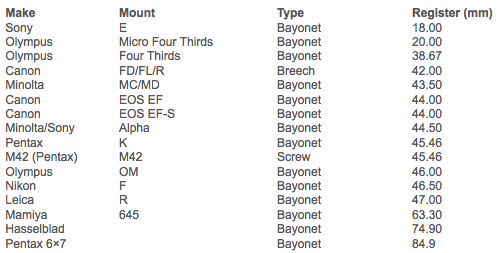
As far as normal DSLRs go, Canon is the most widely adaptable modern mount. Adapters will require chips, but most anything from Pentax on can be adapted to the Canon platform. There are some caveats however. Some lenses, particularly Pentax K-mount lenses can severely damage full frame and 1D APS-H cameras.
The aperture lever on the lenses protrudes into the mirror chamber and will impact the mirror when an image is taken.
Many will permanently modify the lenses, removing the aperture lever. If one never uses a lens on a film body or Pentax digital body, that is fine. It will make the lens unusable to the origin platform if modified. When used on Canon EF-S bodies, this is not an issue, as the lever does not come in contact with the mirror.
The most widely accepting mounts are the new Electronic Viewfinder models, such as the Micro Four Thirds and Sony NEX platforms. These systems have 20mm and smaller registers and can use most any lens of the bygone era. The difference in Register between these small sensor mounts and normal mounts is so great that there are even Tilt/Shift adapters available that allow you to turn a Nikon manual lens into a Tilt/Shift lens.
The downside is that you are using an Electronic Viewfinder or live view, and the larger lenses can get unwieldy with such minute platforms.
Do keep in mind, that shorter Register systems can be used with the aid of an optical adapter. I personally use a Minolta MD/MC to EOS adapter with an optical element inside. Yes, there is a slight degradation in quality and a slight magnification factor. I compensate for the disadvantages by stopping down, but I am completely happy with the purchase as it allows me the use of my vast array of Minolta lenses.

The difference in image quality is fine with me, as I consider that part of the characteristics of the lens when I have it mounted on my Canon. As I previously mentioned I absolutely adore my Minolta Rokkor-PF 58mm f/1.4 with the optical adapter on my Canon.
I lucked into an adapter that barely changes the lens characteristics and only has a 1.4x magnification. It works well for me, but I don’t recommend these adapters as I have seen them vary greatly from adapter to adapter.
One More Thing About Manual Focus Lenses
Before I go, allow me to state one final advantage. Video. If you find yourself shooting video with your DSLR, a manual focus lens can be great for your video techniques. First, you have complete control of aperture, which is always a big plus. But you also gain the ability to fine tune focus by hand. Much more reliably than you can with autofocus lenses. No huge thing, but it is an advantage nonetheless.
If you are shopping for lens adapters, you have two options generally. First, there is eBay. But be warned, product quality is not controlled and you will often find that your orders will be coming from Hong Kong. Upside is, you can find adapters fairly cheap and they generally work acceptably well.
If you want to not leave everything up to chance, look to Fotodiox. They sell a large array of lens adapters, adapting between many different lens/body combination. They cost more, but if you have problems, it is easier to find someone to speak to.
Hopefully, this may be intriguing to some of you out there. Any tools that can expand your photographic abilities are always welcome, and for fairly little expense, mount adapters can provide you with a wide array of new to you lenses and open you up to a new way of taking photos.
